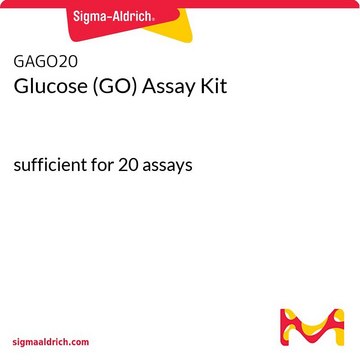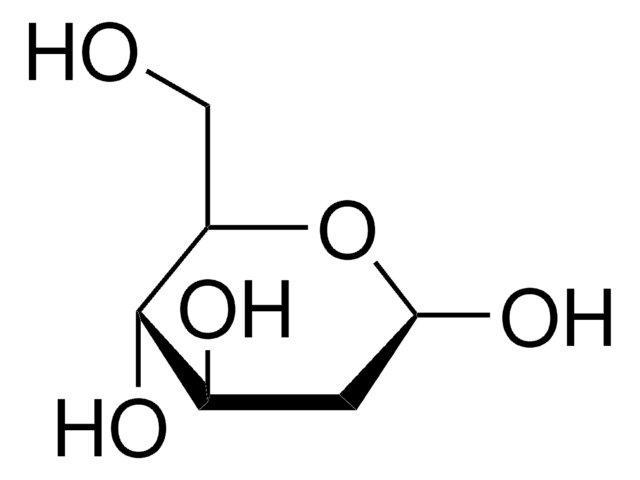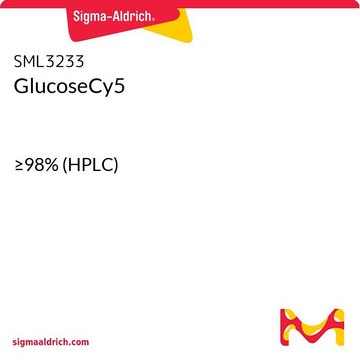72987
2-Deoxy-2-[(7-nitro-2,1,3-benzoxadiazol-4-yl)amino]-D-glucose
≥97% (HPLC)
Synonym(s):
2-NBDG, 2-[N-(7-Nitrobenz-2-oxa-1,3-diazol-4-yl)amino]-2-deoxy-D-glucose
Sign Into View Organizational & Contract Pricing
All Photos(1)
About This Item
Empirical Formula (Hill Notation):
C12H14N4O8
CAS Number:
Molecular Weight:
342.26
Beilstein:
7603370
MDL number:
UNSPSC Code:
12352108
PubChem Substance ID:
NACRES:
NA.32
Recommended Products
biological source
synthetic
Quality Level
Assay
≥97% (HPLC)
form
powder
fluorescence
λex 494 nm; λem 551 nm in DMSO
application(s)
cell analysis
storage temp.
−20°C
SMILES string
OC[C@@H](O)[C@@H](O)[C@H](O)[C@@H](Nc1ccc([N+]([O-])=O)c2nonc12)C=O
InChI
1S/C12H14N4O8/c17-3-6(11(20)12(21)8(19)4-18)13-5-1-2-7(16(22)23)10-9(5)14-24-15-10/h1-3,6,8,11-13,18-21H,4H2/t6-,8+,11+,12+/m0/s1
InChI key
QUTFFEUUGHUPQC-ILWYWAAHSA-N
General description
2-Deoxy-2-[(7-nitro-2,1,3-benzoxadiazol-4-yl) amino]-D-glucose, also known as 2-NBDG, is a fluorescent D-glucose analog. The consequent fluorescent activity is detected by flow cytometry. 2-NBDG is incubated directly with the test sample for uptake, followed by measurement.
Application
2-Deoxy-2-[(7-nitro-2,1,3-benzoxadiazol-4-yl) amino]-D-glucose is used as a fluorescent indicator for direct glucose uptake measurement. 2-NBDG is used as a fluorescent deoxyglucose analog to study the tumor cells. For in vivo imaging of epileptic activity experiments, 2-NBDG is used as a fluorescent deoxyglucose analog.
Packaging
Bottomless glass bottle. Contents are inside inserted fused cone.
Storage Class Code
11 - Combustible Solids
WGK
WGK 3
Flash Point(F)
Not applicable
Flash Point(C)
Not applicable
Choose from one of the most recent versions:
Already Own This Product?
Find documentation for the products that you have recently purchased in the Document Library.
Han-Wei Tan et al.
International journal of cancer, 145(7), 1860-1873 (2019-03-06)
Accumulating evidence illustrates the significance of cell plasticity in the molecular biology of liver cancer. Reprogramming of mature parenchymal cells to a less differentiated state by key molecular targets contributes to the pathogenesis of hepatocellular carcinoma (HCC). Hereby, we investigated
Roger G O'Neil et al.
Molecular imaging and biology, 7(6), 388-392 (2005-11-15)
A new fluorescent analog of D -glucose was recently developed by [Yoshioka K, Takahashi H, Homma T, Sato M, Ki Bong O, Nemoto Y, Matsuoka H (1996) A novel fluorescent derivative of glucose applicable to the assessment of glucose uptake
Chenhui Zou et al.
Journal of biochemical and biophysical methods, 64(3), 207-215 (2005-09-27)
Evaluation of glucose uptake ability in cells plays a fundamental role in diabetes mellitus research. In this study, we describe a sensitive and non-radioactive assay for direct and rapid measuring glucose uptake in single, living cells. The assay is based
Vassiliy Tsytsarev et al.
Journal of neuroscience methods, 203(1), 136-140 (2011-09-24)
Accurately locating epileptic foci has great importance in advancing the treatment of epilepsy. In this study, epileptic seizures were first induced by intracortical injection of 4-aminopyridine in rats. A fluorescent deoxyglucose substitute, 2-(N-(7-nitrobenz-2-oxa-1,3-diazol-4-yl)amino)-2-deoxyglucose (2-NBDG), was then continuously injected via the
Xiumei Wei et al.
Journal of immunology (Baltimore, Md. : 1950), 203(5), 1172-1188 (2019-07-28)
T cells suddenly appeared in jawed fish ∼450 million years ago. Biological studies of fish T cells may provide helpful evidence to understand evolution of adaptive immune systems. To this end, using a Nile tilapia (Oreochromis niloticus) model, we revealed
Our team of scientists has experience in all areas of research including Life Science, Material Science, Chemical Synthesis, Chromatography, Analytical and many others.
Contact Technical Service


